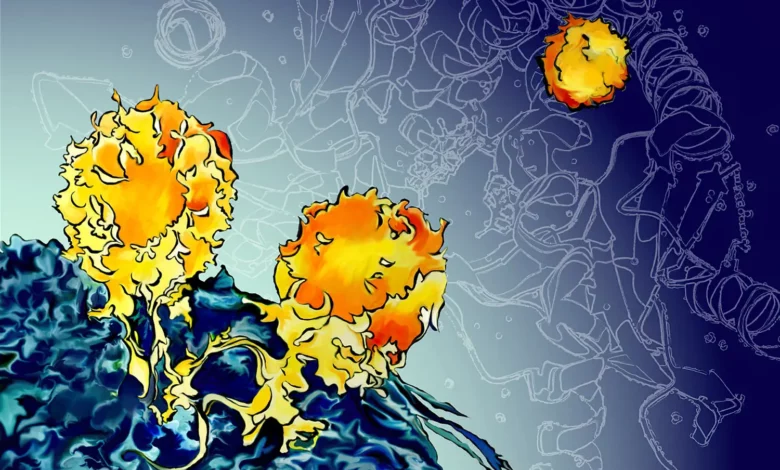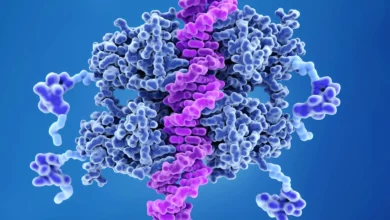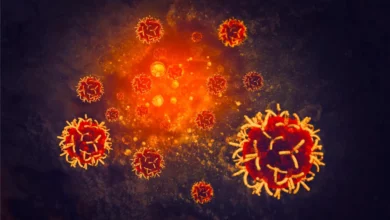
A cancer vaccine combining checkpoint blockade therapy and a STING-activating drug eliminates tumors and prevents recurrence in mice.
MIT researchers have engineered a therapeutic cancer vaccine that targets the STING pathway, vital for immune response to cancer cells. This vaccine has shown significant potential in eliminating tumors, inhibiting metastasis, and preventing recurrence in mouse models of different cancers, with minimal side effects. The treatment is even effective in cases where the STING gene is mutated. The study also revealed an unexpected key role of CD4+ T cells in antitumor immunity.
Immune checkpoint blockade therapies have been revolutionary in the treatment of some cancer types, emerging as one of the most promising treatments for diseases such as melanoma, colon cancer, and non-small cell lung cancer.
While in some cases checkpoint blockade therapies elicit a strong immune response that clears tumors, checkpoint inhibitors do not work for all tumor types or all patients. Moreover, some patients who do experience an initial benefit from these therapies see their cancers recur. Only a small minority of patients treated with checkpoint blockade therapies see lasting benefits. Researchers have developed various combination therapy strategies to overcome resistance to checkpoint blockade therapies, with the STING pathway emerging as one of the most attractive lines of inquiry.
In a study published recently in the journal Advanced Healthcare Materials, a team of MIT researchers engineered a therapeutic cancer vaccine capable of restoring STING signaling and eliminating the majority of tumors in mouse models of colon cancer and melanoma, with minimal side effects. The vaccine also inhibited metastasis in a breast cancer mouse model and prevented the recurrence of tumors in cured mice.
“We have repurposed a naturally existing adaptor protein into a novel, dual-functional cancer vaccine that initiates and sustains an effective antitumoral immunity. The protein complex stimulated robust immune attack and helped form long-term memory against tumors in mouse models of colon cancer and melanoma,” says Angela Belcher, the senior author of the study, a member of the Koch Institute for Integrative Cancer Research, and the head of MIT’s Department of Biological Engineering.
The study was led by MIT postdoc Yanpu He and conducted in collaboration with the laboratory of Paula Hammond, who is also a member of the Koch Institute, an MIT Institute Professor, and the head of MIT’s Department of Chemical Engineering. Other authors of the paper include Celestine Hong, Shengnan Huang, Justin Kaskow, Gil Covarrubias, Ivan Pires, and James Sacane.
Building blocks of a vaccine
Immune checkpoints are a key part of a system that helps the immune system tell the difference between the body’s own healthy cells and threats such as harmful bacteria or cancer cells. When checkpoint proteins on the surface of immune cells bind to partner proteins on other cells, the interaction gives rise to a signal that prevents T cells and other immune cells from mounting an attack. By presenting the same type of partner proteins, cancer cells can evade destruction by the immune system. Immune checkpoint blockade therapies — the discovery of which was recognized by the 2018 Nobel Prize in Physiology or Medicine — work by binding to partner proteins on cancer cells and allowing the immune system to respond.
The STING pathway holds promise as a partner for immune checkpoint blockade therapies because of its key role in raising immune response to pathogens and cancer cells. The pathway is also known to impact the immune system in other ways, including the maturation, specialization, and activation of certain types of immune cells.
“We have repurposed a naturally existing adaptor protein into a novel, dual-functional cancer vaccine that initiates and sustains an effective antitumoral immunity.” — Angela Belcher
Although there are multiple ongoing clinical trials that combine an immune checkpoint blockade with a STING-targeted therapy, few have obtained approval from the U.S. Food and Drug Administration, largely because they can cause serious toxic and inflammatory side effects when administered systemically. Side effects can be limited by injecting STING directly into the tumor, but this strategy still leaves one serious challenge unanswered: Nineteen percent of people carry mutated versions of the STING gene and do not respond to STING-targeted therapies.
In past work, the researchers worked to address this challenge by engineering a protein complex capable of restoring STING signaling in cell lines that lacked STING protein or had a mutated and ineffective version of the gene. The complex combined a piece of the STING protein responsible for triggering the downstream signaling with cGAMP, a small molecule that stimulates the STING pathway.
In the present study, the team added one more component to the STING-cGAMP complex: a smaller form of an antibody known as a nanobody carrying immune checkpoint blockade therapy.
After direct injection into tumors, the cancer vaccine eliminated 70-100 percent of tumors in mouse models of colon cancer and melanoma. The researchers found that most of the vaccine remained within the tumor and that treated mice lost minimal weight, suggesting that the risk of systemic side effects is low. Cured mice remained tumor-free after six months of observation, and when researchers rechallenged the mice with tumor cells to simulate cancer recurrence, 100 percent of those mice rejected them through immune memory. When mice whose STING genes were inactivated were treated, the vaccine still restored STING signaling and significantly reduced the size of tumors, although not as effectively as in mice with normal STING function.
“With further development, this platform not only promises to increase the effectiveness of checkpoint blockade therapies and prevent recurrence for cancer patients more broadly,” Belcher says, “but it may lead to a novel cancer treatment that could make checkpoint blockade therapy viable for large fraction of the human population with loss-of-function STING mutations.”
A surprising role for CD4+ T cells
When the researchers investigated the mechanisms of tumor response to the vaccine, they found — contrary to their expectations — that a subtype of T cells called CD4+ T cells played a pivotal role in achieving antitumor immunity.
In clinical cancer treatments, CD4+ T cells play various roles in the immune system and are usually associated with immunosuppression. Subsequently, most research on checkpoint blockade therapies and the STING pathway has centered on other types of immune cells whose roles in raising immune responses are better understood — for instance, natural killer cells and CD8+ T cells, both of which are responsible for attacking tumor cells. The importance of CD4+ cells has only been recently discovered for immune checkpoint blockade therapies, while their role in STING signaling has only been investigated in cell lines or in the context of preventive and not therapeutic vaccines.
Researchers found that the cancer vaccine changed how CD4+ T cells behaved in tumors. After depleting different populations of immune cells, the researchers tracked how the tumors responded after treatment. While depleting macrophage and natural killer cells only partially compromised the effectiveness of the vaccine, CD8+ T cells were predictably essential. However, CD4+ T cells were likewise indispensable. Without CD4+ T cells, tumors treated with the vaccine behaved as if they received no treatment at all.
CD4+ T cells can develop into several different subtypes with different functions. In tumors, CD4+ T cells frequently develop into the regulatory T (Treg) subtype that suppresses immune response. But with the cancer vaccine, researchers found that STING signaling polarized the CD4+ T cells into the T helper Type I (TH1) phenotype, a helper T cell that activates other immune cells to attack tumor cells.
“A key to leveraging CD4+ T cells in cancer therapies may be in understanding how they are polarized and activated,” says He. “Mechanistic insights from this study could inform future work on CD4+ T cells, allowing researchers to unlock the significant therapeutic potential of these cells for human cancer patients.”
Researchers believe that their approach could be developed into a modular platform, using different types of immune checkpoint blockade therapies. In future work, they plan to fine-tune their therapeutic strategy to improve potential outcomes for patients who carry STING mutations, for example by adjusting the dosage and timing of treatment and exploring the use of other nanobodies to engage immune cells.
Reference: “STING Protein-Based In Situ Vaccine Synergizes CD4+ T, CD8+ T, and NK Cells for Tumor Eradication” by Yanpu He, Celestine Hong, Shengnan Huang, Justin A. Kaskow, Gil Covarrubias, Ivan S. Pires, James C. Sacane, Paula T. Hammond and Angela M. Belcher, 4 April 2023, Advanced Healthcare Materials.
DOI: 10.1002/adhm.202300688
The study was supported in part by the Koch Institute Frontier Research Program and the Marble Center for Cancer Nanomedicine.





